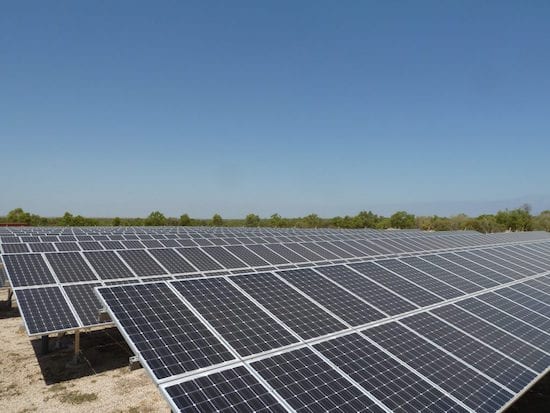Western Australia’s Pilbara region must first prove its ability to deliver cost-effective utility-scale solar and storage, before it can become a regional hub for solar energy exports to Asia, a new report has found.
The Pilbara Solar Export Pre-Feasibilty Study, which was officially released by the Pilbara Development Commission on Tuesday morning, examines a ‘pilot’ project, to provide 3GW of Pilbara-generated solar to the Java grid.
As we reported here yesterday, the report found that a commercial case for the project could be established within five to 10 years, including the construction of a $9.5 billion, 1500km sub-0sea cable from the Dampier Peninsula to east Java and three 1GW solar farms.
“The preliminary engineering and costing analysis shows that the 3GW solar generation Pilot Project with HVDC connection to Java may have commercial potential,” it says, adding that “the falling costs of solar and storage may confirm this in the near future.”
The figures the report comes up with on cost are 18-25 c/kWh “over the long term,” with earnings of 19-20 c/kWh from the solar feed-in tariff applicable in Java.
But, as the report’s authors – Samantha Mella, Geoff James and Kylie Chalmers – point out, these figures are subject to numerous uncertainties and even a few unknowns.
“There are technology and supply chain uncertainties on the cost side, and the need for a negotiated outcome recognising strategic benefits on the revenue side,” the report says.
But perhaps most importantly, the report finds that the successful export of solar PV generation from WA’s north-west would depend on first building up a local large-scale solar industry in the Pilbara, where virtually nothing of the sort currently exists.
“The Pilbara must first have a local solar industry to be able to offer Indonesia competitive rates on large-scale solar generation,” the report says.
“Ultimately, cost is the critical factor. The LCOE must be cost-competitive, with the large overhead of the subsea interconnector.
“An experienced solar industry in the Pilbara with a proven ability to deliver cost-effective utility scale solar, potentially with storage, would significantly improve the economic case.
“A local industry will build the solar supply chains and become more competitive with experience and scale,” the report says.
The report recommends the region’s solar generation capacity should be built up by small stages – starting with a 20MW facility and then expanding production to several solar generators each serving a load within the Pilbara (new capacity of 180 MW) – to nurture a local supply industry that can develop projects properly adapted to local conditions.
The report is particularly enthusiastic about the potential for the resource-rich WA region to lead the country – if not the world – in solar-diesel hybrid energy system development, given its proliferation of mining projects currently powered by diesel and gas.
“The Pilbara has over 1,400MW installed capacity of gas and diesel off grid,” it notes. “A successful model for the solar diesel hybrid has been demonstrated in WA with the DeGrussa Mine, owned by Sandfire resources.
“The opportunity to scale up with solar diesel hybrids has the potential to bring many benefits to all stakeholders, regardless of whether an agreement is reached with Indonesia.”
As for the role of WA as a solar exporter to the east coast of Australia, the report says this is “unlikely to be commercially viable as a stand-alone proposition,” due to the market returns being so much lower in the NEM.
Annual revenues from the 3.4GW of solar PV generation are estimated at $1,622 million based on the solar feed-in tariff allocated to Java, the report finds, while they come to just $284 million based on NEM NSW wholesale prices in 2010.
This is a shame, the report notes, considering exporting solar energy from Australia’s west to its east could be a value-adding exercise, all round.
“Due to the time difference, afternoon solar energy in the Pilbara would supply into the evening peak demand on the east coast, and would correspondingly have a high value in the National Electricity Market (NEM). Delivering to the NEM, in addition to Indonesia, would also mitigate the risk of depending on a single market.”
On battery storage, the report notes that the above calculations do not show how the HVDC transmission line could be used more efficiently through the integration of energy storage.
“Battery energy storage can be integrated without increasing LCOE due to improving the HVDC capacity factor and makes the solar generation fully dispatchable, increasing its value to the local and international markets,” the report finds.
As for who might build these gigawatt-scale solar farms, Western Australia’s minister for regional development, Alannah MacTiernan, says the project would be privately funded, with no direct investment from the state.
“We will get feedback from industry players to see what the interest might be and then to see what additional work there needs to be if there is genuine interest in this,” MacTiernan said in a statement on Monday.
The report notes that, in consideration of Native Title laws, and in keeping with corporate social responsibility, there was an opportunity for some Aboriginal groups in the Pilbara to own, or co-own solar farms as income-producing assets.












